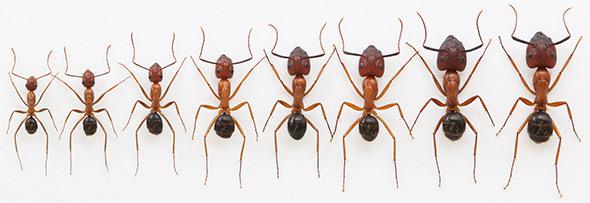On the surface, superheroes and scientists don’t have a lot in common, but there are more parallels than you might think. In the Marvel universe, mad genius Hank Pym discovered how to shrink himself down to the size of an ant. In real life, researchers have figured out how to shrink actual ants. Unlike Pym, who used his size-changing powers to fight crime as Ant-Man, these scientists are using theirs to expose how genes are expressed.
We’ve long known that genes influence traits like size; taller parents tend to have taller children. But genes aren’t everything; they interact with environmental factors, and scientists’ understanding of what counts as the “environment” and how it contributes to gene expression has been murky at best. For instance, all sorts of outside factors affect how genes for size are expressed over our lifetimes: illnesses, the amount of sleep we get, what we ate as kids, what we eat now, and even what our mothers ate while we were in the womb. The new research with ants, published Wednesday in Nature Communications, has homed in on a mechanism by which the environment can influence genes, called DNA methylation.
DNA methylation starts in utero, and it’s an important step in embryonic development. During methylation, molecules that determine whether, where, and when certain genes will function are added to DNA. Abnormal methylation can lead to diseases like cancer and lupus.
Most methylation studies have focused on how the process can send an embryo down one developmental path or another—for instance, whether a larval honeybee becomes a lowly worker or a queen bee. In this new study, scientists showed that methylation can cause a continuum of differences. The researchers, from McGill and Stanford, noticed that carpenter-ant size was related to the amount of methylation of a size-regulating gene called Efgr, so they gave ants drugs to manipulate Efgr methylation. They found that ants with increased Efgr methylation grew bigger, while ants with decreased methylation were smaller. In fact, some ants they bred were of comic-book proportions: They were smaller than ants you’d find in the wild.
These studies offer a glimpse into how to influence gene expression. “You’re born and you die with the same genes, and that sometimes leads people to take a deterministic view: Why bother going on a diet if I was born with these genes?” lead author Sebastian Alvarado told me. These studies “give more credit to the role of environment.”
For Alvarado, these results also fulfilled a lifelong dream: using science to explain fiction. A long-time comic-book aficionado, Alvarado was excited to discover a possible real-world explanation for the Marvel universe character Ant-Man. One of the first things he did after the team made its discovery was call up Marvel Studios executive producer Kevin Feige to share the news. “His secretary hung up on me,” says Alvarado. “But she was probably just doing her job.” Here’s hoping that Alvarado’s next project sheds light on Wolverine’s healing powers.
